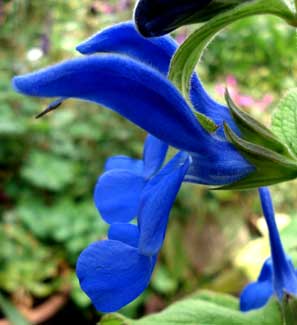
'Blue Angel'
Gentian Sage
'In that manner,' replied Don Quixote, 'we have nothing left us to eat today.' 'That would be so,' quoth Sancho, 'if we could not find among these fields the herbs which I have heard you say you know, wherewithal such unlucky knights-errant as you are wont to supply like needs.' 'For all that,' quoth Don Quixote, 'I would rather have now a quarter of a loaf, or a cake, & two pilchard's heads, than all the herbs that Dioscorides describeth.'
-Miguel de Cervantes Saavedra
(1547-1616)
Salvia patens 'Blue Angel' at two-foot height is smaller than & a deeper blue than another cultivar for the genus we have had in the garden, S. patens 'Guanajuato.' 'Guanajuato' died out of the garden after a couple of good years.(1547-1616)
We intended to replace it, but locally only 'Blue Angel' was offered, & it was just as pretty but a little less likely to tip over due to shorter height, so we grabbed it. We don't as yet know if 'Blue Angel' will perennialze for a longer time or end up a virtual annual. .
The species is right on the margins for reliable perennializing on Puget Sound. Given perfect drainage & lack of too much dampness in winter (that's the hard part with our rainy seasons), the rhizomatous root can spread & produce a bigger clump every year. The rhizomes eventually fatten into tubers & thereafter much hardier, but it's very hit-and-miss reaching that outcome in a region with as much autumn-through-spring rainfall as we have.
Some gardeners will find it essential to lift the clump as one would dahlia tubers to store each winter, though we've decided that even if we only have them as de facto annuals they're worth it for the wondrous blue parrot-beak blossoms.
With luck they will return mid to late summer their second year then bloom continuously until the first really hard frost of late October or November. They can also be started from seed indoors to insure good flowering come summer. It flowers about three months after sprouting, so get them started in a sunny warm indoor location as early as you can.
Their tenderness in our zone & the lateness of their season probably means I shouldn't keep trying to get a really nice patch of these going. But I've seen some local gardens with lots of them doing quite well, & so I keep trying any variety that has a chance of flourishing, even though so far my best outcome has been to have them hold their own as small clumps.
'Guanajuato' we had in a very sunny but generally neglected area that received only occasional summer watering, & over a few years the soil may have become a little too compacted to insure the requisite perfection of winter drainage. 'Blue Angel' we're trying in a semi-droughty sun-garden that does get regular watering in the longest hottest days of summer, & has very good loose soil.
It's done splendidly as a new planting, & fingers are crossed that it does more than just "hold its own" for a few years or worse yet vanish forever after a wet winter. With luck it could be more vigorous with each passing year. Here's hoping my next year update will be a happy report.
See also the similar parrot-beaked blue sage:
Salvia guaranitica 'Black & Blue' Anise Sage